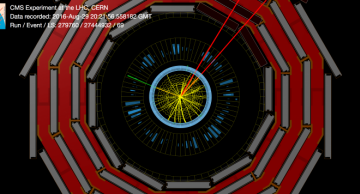The CMS collaboration has carried out for the first time a direct search for a Higgs boson decaying into charm quarks, a vital step in understanding the Higgs particle and the Standard Model.
The discovery of a Higgs boson by both the ATLAS and…
Not many people know that there is a boson-boson collider hiding in the proton-proton collisions of the Large Hadron Collider. The idea is that during rare occasions other particles such as the photon and gauge bosons W and Z are created by the…
The CMS Collaboration has recently presented an updated search for new invisible particles. The technique capitalizes on the imbalance among the visible particles in a collision that such an object would induce. If dark matter is made of fundamental…
New physics may show up at the LHC in the form of yet unobserved particles which travel inside the detector before decaying, far from the point in space where they were produced. If these particles decay to photons, at CMS we can use the short but…
At the EPS-HEP conference this week the CMS collaboration presents new results of a powerful search that is motivated by a variety of new physics models that predict a signature of a bump in the production of the most frequently produced particles…
The CMS collaboration has recently released new results on how the top quark and Higgs boson interact, and this required a much deeper understanding of the production of top quarks together with bottom quarks.
The two heaviest known elementary…
The study of dark matter is one of the primary research topics at the CMS experiment. The standard model of particle physics describes the behavior of elementary particles with incredible accuracy but provides no explanation or possible particle…
Physicists at the CMS experiment are now very close to observing the simultaneous production of four top quarks (really two top quarks and two antitop quarks, but particle physicists describe this process as tttt) at the Large Hadron Collider for…
There is copious astrophysical and cosmological evidence for dark matter, but no indication of how it was produced, how it interacts with regular matter, or how it could fit into an inclusive model of particle physics. One possibility is that dark…
Since the discoveries of the third generation of quarks and leptons starting in the 1970s, physicists have asked the natural question "Can there be more generations?". One of the first key results from the Large Electron Positron collider LEP…
Over the past century, physicists have developed a theory governing the fundamental interactions of elementary particles, known as the Standard Model of Particle Physics. Thus far, it has stood up to many experimental tests with an extraordinary…
The Standard Model of particle physics asserts that the Higgs boson generates the mass of all fundamental particles. In 2012 a new particle was discovered at the CERN LHC that behaves closely like the Higgs particle predicted by the Standard Model.…












